Srivalli Rekha (Semi Hiatus)'s Blog, page 29
April 24, 2024
V for Varuna’s Sabha - Mahabharata Mashup
Namaste,
Narada described various celestial courtrooms(Sabha) to Yudhistira during his visit to Indraprastha for the first time. Thisevent took place in Sabha Parva. We have seen Brahma’s Sabha, Dwaraka, Indra’sSabha, and Kubera’s Sabha until now.
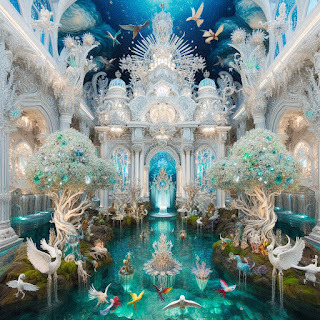
Varuna is the god of rain, water, ocean, seas,rivers, etc. His Sabha is called Pushkaramalini and was built by Vishwakarman,the celestial architect. True to his powers, Varuna’s Sabha is locatedunderwater (in an ocean) and has the right temperature for everyone to thrive.It has white walls and arches and is the same size as Yamadharmaraja’s Sabha(we’ll do this next).
The Sabha is surrounded by celestial trees withgemstones, lovely blooms, and fruits. Plants of all colors - turquoise, yellow,black, purple, white, and red can be found in this Sabha. Exotic birds are alsoa part of it. The sweet melodies of the birds fill the Sabha.
The rooms are large and artfully decorated to suitVaruna’s taste. He is accompanied by his queen Varuni and lords over the Sabhawith many heavenly creatures, beings, rishis, kings, and gods. For example, theNagas are predominantly found in his Sabha. Similarly, Kings like Bali, Prahalada,Naraka, and many daityas (anti-gods) are also present.
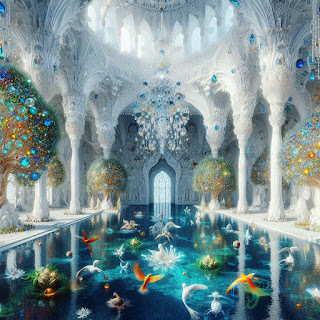 The oceans, seas, and rivers are a part of Varuna’sSabha, along with lakes and tiny ponds. All aquatic creatures can be seen inthis Sabha, sharing space with the Gandharvas, Yakshas, and apsaras. Varuna’sminister Sunabha, with his sons and grandsons, waits on him near the holy placeof pilgrimage called “Gau” or Puskara.
The oceans, seas, and rivers are a part of Varuna’sSabha, along with lakes and tiny ponds. All aquatic creatures can be seen inthis Sabha, sharing space with the Gandharvas, Yakshas, and apsaras. Varuna’sminister Sunabha, with his sons and grandsons, waits on him near the holy placeof pilgrimage called “Gau” or Puskara.Sounds beautiful, doesn’t it?
I’m participating in #BlogchatterA2Z.
The AI images are made on Bing.
A Letter to the Luminous Deep by Sylvie Cathrall - Book Review
Series: The Sunken Archive #1 (cliffhanger)
Publication Date: 25th April 2024
Genre: Fantasy, Romance, Mystery, Epistolary
3.5 stars
One Liner: Ultra-slow-motion; but beautiful!
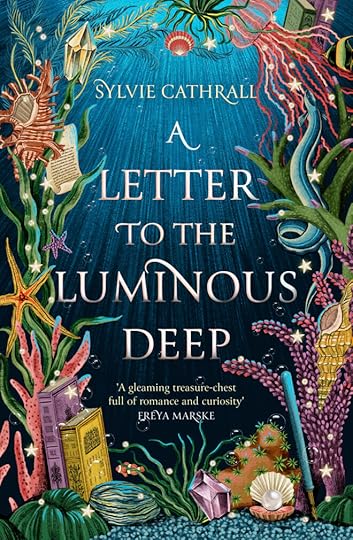
E. sends a letter to renowned scholar Henerey Clel after she spies an intriguing aquatic animal outside her window. Soon, they correspond regularly and fall in love. However, life in the underwater world has its risks. When the duo uncovered a mystery, they didn’t know it could destroy E.’s home. E. and Henerey vanish, presumed dead.
A year later, E.’s sister Sophy begins to archive her articles. She contacts Henerey’s brother Vyerin, and they begin to go through the letters and notes to discover more about their siblings and the mystery.
What happened and why? How does the truth change their lives?
The story comes in the form of letters, news reports, and other snippets shared by different characters.
My Thoughts:Firstly, a huge thanks to an early reviewer. Her review helped me go into the book with the right expectations (ultra-slow pacing, almost non-existent plot, and a cliffhanger). I’m sure I enjoyed the book more because I knew what it was going to be.
The beginning is intriguing but soon dissolves into a lengthy character-building exercise. While the idea of showing character development only through letters and journal entries is a great idea, it cannot come at the cost of the plot.
I continued to read and read and read and finally, after 70%, saw a ray of hope. Maybe if the letters were shuffled to provide two tracks – one to get to know the characters and another to follow the mystery, we might feel better involved in the book.
The underwater setting is ambitious. It takes time to understand the whole thing, so wing it until you get a hang of it. There are enough details to picture the setting, so it shouldn’t be too much of an issue. Moreover, the technology and stuff used can be compared to what we have, making it even easier to create parallels.
There’s no denying E.’s arc. It is indeed beautifully done. Sophy and others are well done, too, but E. shines just as she should. Henerey is equally adorable. My only grouse is that the plot and pacing needed to be sacrificed for this.
The letters are formal, with many post scripts, dashes, and parentheses. Do I mind it? Nope! That’s how they are supposed to write. It aligns with their professions and backstories. However, I wish the voices were a little more distinct. Giving them each a quirky trait might have helped. On a side note, I have no idea how this would work on audio.
The last section is truly where things start to come together. But it shouldn’t have been left until that point. Strengthening the threads from the midpoint would have worked even better.
Also, sorry, but E. Cidnosin sounds a bit too close to e coli (at least to my brain). It’s a me thing, but I had to mention it. Her full name, though! Poor girl. I understand why she preferred E.
To summarize, A Letter to the Luminous Deep is a character-driven book that sets the stage for the next book while providing snippets of information. Whatever is revealed is my kinda stuff, so I would love to read the next book and see where it goes.
Thank you, NetGalley and Little Brown Group (Orbit), for eARC.
#NetGalley #ALettertotheLuminousDeep
April 23, 2024
U for Usinara’s Test - Mahabharata Mashup
Namaste,
Usinara is one of the Hindu kings from ancient times(Dwapara Yuga). He was known as a fair ruler and a yagna performer. One day, hewas participating in a massive yagna that surpassed even Indra’s attempts. Indraand Agni wanted to test Usinara to check if he was his dedication to justiceand dharma was true.
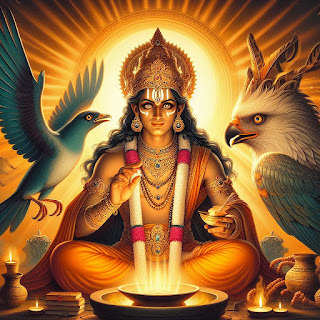
Indra became a hawk, and Agni turned into a dove.The dove flew towards Usinara and asked for his protection as the hawk swoopedbehind. Unisara shielded the dove with his hands.
The hawk said to Usinara that he was acting againstdharma by preventing him from eating his food (the dove). The dove trembled inUsinara’s lap in response.
Usinara replied that his dharma was to offerprotection to the dove that took shelter in his arms. The hawk retorted thateating its food was its dharma and that it would die without food. It askedUsinara to do the right thing.
The king said he would offer as much meat as thehawk wanted to consume. He gave the hawk options like ox meat, boar meat,buffalo meat, etc. The hawk didn’t want any other meat, as doves and pigeonswere its food.
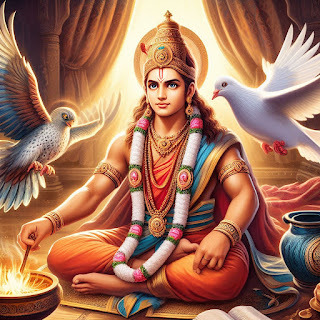
King Usinara said he would offer all his wealth andanything the hawk asked except for the dove, which was under his protection.The hawk demanded a portion of the king’s flesh in the same weight as the dove.The king readily agreed.
The guards brought a scale. Usinara cut a piece ofhis flesh and placed it on the scale. The dove was heavier. This happened a fewtimes. At last, the king stepped on the scale and asked the hawk to consumehim.
The hawk and the dove transformed into Indra andAgni. They praised him for his dedication to dharma and healed his body. Indra blessed Usinara that his glory would be sung forever and that he would find aplace in heaven after his demise.
The same story is also attributed to King Sibi,Usinara’s son. Both can be found in Aranyaka Parva of Mahabharata. It is a popular storyin the folklore and has been retold in many ways over the years.
I’m participating in #BlogchatterA2Z.
The AI images are made on Bing.
April 22, 2024
T for Takshaka, the Naga King - Mahabharata Mashup
Namaskar,
We have read about Takshaka in . He is the king of Nagas from the Patala (underground kingdom) and isa descendant of the Airavata family.
Takshaka was first mentioned in Adi Parva when hestole earrings from Rishi Uttanka. This incident angered Uttanka, who laterwent to King Janamejaya’s court in Hastinapura and informed him of Takshaka’srole in the death of Parikshit (J’s father).
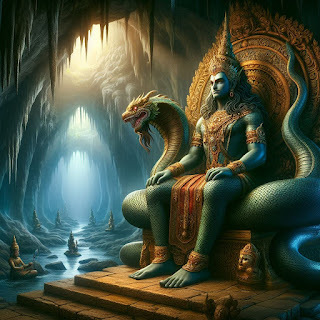
Parikshit was a capable and loving ruler ofHastinapura. One day, however, during a hunt, he was tired and went to arishi's ashram, where he insulted a rishi who was in maun-vrat (vow of silence) by placing a dead snake around his shoulders. Though therishi forgave the king, his son Sringin cursed Parikshit that he would die in aweek due to a snake bite. The old rishi sent his student to inform Parikshit about the curse.
Parikshit then built a tower with no doors and windowsand stayed in it. Many rishis, even from far-off places, arrived to treat himif the need arose. However, Takshaka found a way to hide in a basket of fruitscarried by the rishis. When Parikshit grabbed a fruit, Takshaka rose from the basketand bit the king, ending his life as per the curse.
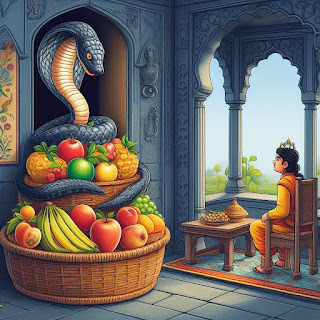
This information made Janamejaya angry, which led tothe snake sacrifice. Of course, we know that even that wasn’t successful, andTakshaka was saved in the last moment when Janamejaya agreed to grant Astika’sboon.
If we see the events, we notice how determinedTakshaka was to end Parikshit’s life. But why?
Well, we could say the answer lies in the past. Takshaka and hisfamily lived in the Kandava forest, the same one Agni wanted to consume asfood. Arjuna and Krishna helped Agni devour the forest, which led to the deathof Takshaska’s family (he wasn’t in the forest when the incident occurred). Hiswife saved their son, Asvasena, in the burning.
However, Asvasena wanted revenge and waited manyyears. When Karna and Arjuna had a face-off on the 17th day of the Kurukshetra War, Asvasena became anarrow in Karna’s quiver. Krishna saw this and pressed the chariot wheels intothe ground, thus causing the arrow (Asvasena) to strike Arjuna’s crown.Asvasena asked Karna to use his as an arrow again, but Karna refused, saying hedidn’t need anyone's help to kill Arjuna. Asvasena attacked Arjuna directly butwas killed by his arrows.
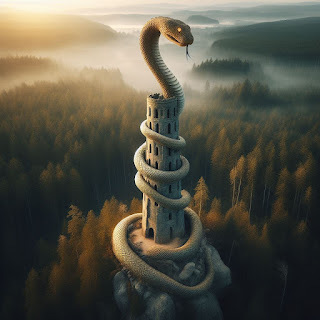 We can assume that Takshaka held Arjuna responsible for everything.When Parkishit was cursed, he made sure it was he who fulfilled the curse andgot his revenge by killing Arjuna’s grandson. It took Astika and Janamejaya tocreate a truce between the Kurus and Nagas.
We can assume that Takshaka held Arjuna responsible for everything.When Parkishit was cursed, he made sure it was he who fulfilled the curse andgot his revenge by killing Arjuna’s grandson. It took Astika and Janamejaya tocreate a truce between the Kurus and Nagas. I’m participating in #BlogchatterA2Z.
The AI images are made on Bing.
April 21, 2024
S for Samudra Manthan: The Churning of the Ocean - Mahabharata Mashup
Namaskar,
This is my second most favorite topic of thechallenge. Samudra Manthan, or the churning of the celestial milky ocean, is awonderful episode from Srimad Bhagavatam. It gets a brief mention in the AdiParva before the actual story begins.
So, one day, the gods held a meeting on Mount Meruand discussed how too many of them were getting killed or injured due to theconstant attacks of the daityas (anti-gods). They asked Brahma for help, whotook them to Maha Vishnu. He advised them to churn the Kshera Saagaram (Oceanof Milk) to obtain the nectar of life, amrita (an elixir that would make themimmortal). He also told them to strike a deal with the anti-gods since the churning wasn’t an easy task.

Once the whole thing was settled, Mount Mandara waschosen as the churning rod. However, it sank into the water. That’s when KurmaRaja (the king of Tortoise) agreed to hold the mount on his back. The oceanagreed to allow them to churn her if they shared the gifts with her.
Acting on Maha Vishnu’s advice, the gods requestedAnanta (Sesha Naga), a majestic snake, to carry Mount Mandara to the ocean andact as the rope. The anti-gods held Ananta’s face while the gods held his tailand began to churn.
It was a back-breaking job, but both sides refusedto give up. Maha Vishnu gifted them the necessary strength to keep going. Theorder and list of items that appeared from the ocean vary in differentversions.
As they churned, the moon rose from the water andwent into the sky. Then came out goddess Lakshmi, sitting on a lotus flower.She married Maha Vishnu.

Suradevi (the goddess of wine) came out of thewaves. The anti-gods thought it was nectar, but realized the truth later. The gods invited Suradevi(also called Varuni) to live in heaven. She acceptedthe invitation.
Note: There’sa SuraDevi Temple in Dehradun.
The Kaustuba jewel came out dazzling and adornedMaha Vishnu’s chest. It is a large and radiant ruby.
The apsaras came out dancing and chose to stay inthe heaven.
Next, the Kalpavriksham (the wish-fulfillingparijata tree) appeared from the ocean. Indra’s wife, Sachi Devi, requested toplace it in her celestial garden.
Three animals – Surabhi (Kamadhenu)- thewish-fulfilling cow, Airavata- the four-tusked elephant, and Ucchaihsravas- awinged white horse, also appeared as a result of the churning. Surabhi wasgifted to the rishis by Brahma. Indra took Airavata, and King Bali asked to keepUcchaihsravas.
Halaahala or Kalakuta, the most deadly poison, cameout fuming, choking everyone. They were terrified and asked Shiva to handle thepoison as it could destroy the world (in many versions, the poison comes outfirst and is followed by other items). Shiva agreed and held the Kalakuta inhis throat. This turned his throat blue, and he got the name Neelakanta.
I recently read a book, FloralFolklore, which had a mini addition to this story. According to the storyin the book, a few drops of the Kalakuta still dripped onto the earth. Aconiteplants grew from this poison and contain the same properties.
At last, Dhanvantri, the physician of the gods,arrived through the waves, carrying a pot of amrita in his hands. The devas anddaityas were excited. The daityas stole the pot from him and ran away into the caves.

Maha Vishnu transformed into a beautiful young womancalled Mohini and went to retrieve the pot of amrita. He then distributed theamrita among the gods. A daitya sneaked past and consumed a drop of the amrita. Though he was captured and killed, the amrita made him immortal. He became Rahu and Ketu (Rahu is the head and Ketu is the body), the two shadowy planets added to the rest in Vedic astrology.
The remaining amrita was safeguarded in the secret chambers ofheaven with guards and magic protecting the place.
I’m participating in #BlogchatterA2Z.
The AI images are made on Bing.
Invitation to Italy by Victoria Springfield - Book Review - Blog Tour
Genre: Contemporary Fiction
Publication Date: 14th March 2024
Purchase Link (US): https://www.amazon.com/Invitation-Italy-Victoria-Springfield-ebook/dp/B0CF4S132C
Purchase Link (UK): https://www.amazon.co.uk/Invitation-Italy-Victoria-Springfield-ebook/dp/B0CF4S132C
Goodreads Book Page: https://www.goodreads.com/book/show/195963232-invitation-to-italy
3.7 Stars
One Liner: Heartwarming
 Book Blurb
Book BlurbAbi is distraught when her ex-husband Alex takestheir twelve-year-old daughter, Chloe, to spend the summer with his glamorousfiancée Marisa and her parents at their home on the beautiful Italian island ofProcida. Persuaded by her best friend to book a holiday at the island's HotelParadiso, Abi finally meets the woman she's been avoiding for so long. Will thetwo women's strained relationship survive the summer?
One-time teenage swimming sensation Loretta has runthe Hotel Paradiso since leaving Capri broken-hearted. When childhood friendSalvo comes to stay, Loretta is forced to confront her past and the fears thathave kept her away from the water for forty years. But just as she finds thecourage to open her heart, she discovers all is not as it seems with Salvo...
It's a summer of new beginnings for Abi and Loretta- and one they will never forget.
Take a trip to Italy with VictoriaSpringfield for a summery getaway any time of the year!
My Thoughts:The story comes in the third-person POVs of Abi andLoretta, with a couple of sections from Flavia and Chloe’s POVs.
I grabbed this book mainly for the setting and amhappy with the results. The Italian island, Procida, comes alive on the pages;be it the alleys, the artwork, the summer sun (eek!), the food, or thesparkling waters surrounding it. With the characters exploring the place, it iseasy to join them on a virtual tour and visualize the elements while readingabout the local history.
The characters are decently done. Chloe is prettymuch a tween; a kid but not a kid. Kind of mercurial like most kids of thatage. Abi’s growth is well done, though I wouldn’t have minded a little more.Loretta shines throughout! I really enjoyed the scenes with her and how shemanages the hotel.

Bill and Alex are a bit 2D. What you see is what youget. That’s okay since they do their job to keep the story going. Bill has abetter arc and more space, which is a good thing. And oh, I have to mentionCherry. Everyone needs a friend like her!
The stories run in parallel, and a couple of minorthreads open midway. One of those could have been handled better. It was summedup in a line later.
The main tracks give us both stories. We see how Abiand Loretta have to do something different than what they are used to and healfrom the past to move on and find happiness. There are quite a few secrets,too.
The book has (squeaky) clean romance, which is moreof a natural progression of the plot rather than the primary focus. Thepriorities continue to be clear from start to finish, making it easy to enjoythe story.
Things do get worse before they get better, so in away, we have the third-act breakup and disturbance on multiple levels. They getresolved one by one and it comes together in the final chapter.
There’s a short epilogue to tie up everything into aneat bow. I like epilogues and wouldn’t mind if it was longer and a bit moredetailed.
To summarize, Invitation to Italy is a heartwarmingand steady-paced read with a wonderful setting. It’ll make a good beach readyou can finish in a couple of sittings.
Thank you, Rachel's Random Resources and OrionPublishing, for eARC. This review is voluntary and contains my honest opinionabout the book.
***
About the Author – VictoriaSpringfield
Victoria Springfield writes contemporary women'sfiction immersed in the sights, sounds, and flavors of Italy. Victoria grew upin Upminster, Essex. After many years in London, she now lives in Kent with herhusband in a house by the river. She likes to write in the garden with aneighbor’s cat by her feet or whilst drinking cappuccino in her favorite café.Then she types up her scribblings in silence whilst her mind drifts away toItaly.
Connect with her: https://twitter.com/VictoriaSwrites
***
This has been a stop on the #InvitationToItaly blogtour conducted by Rachel's Random Resources. (@rararesources)Thanks for stopping by!

April 19, 2024
R for Ravana’s Family History - Mahabharata Mashup
Namaste,
Wondering what Ravana is doing in Mahabharata?Ramanaya is summarized in Mahabharata in three or four instances by differentcharacters. Rama, Sita, Hanuman, and Ravana are mentioned quite a few times.Vibhishana (Ravana’s brother who ruled Lanka after his death) had a small rolein Sabha Parva as one of the kings who sent tribute to Yudhistira for theRajasuya. Vibhishana is a chiranjeevi (someone who lived for a really longtime) and was still ruling Lanka even as the Treta Yuga changed to DwparaYuga.
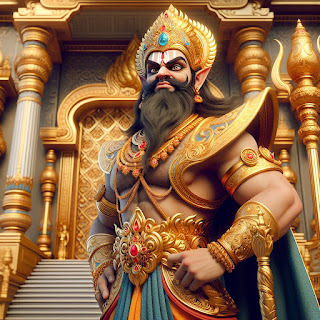
In Arnyaka Parva, Rishi Markandeya narrated Ramayanato Yudhistira to cheer him up. Unlike other versions, this one began withRavana’s family history.
Ravana was the grandson of Prajapati. Prajapati had a mind-born son Pulastya. One of Pulastya’s sons was Vaisravana-Kubera (the Yaksha king).When Kubera chose his grandfather over his father,Pulastya was enraged and created another being from himself called Visravas.(This form wasn’t a son but the darker version of Pulastya. Alter ego types.)
Meanwhile, Prajapati was pleased withVaisravana-Kubera and gifted him wealth, guardianship duties, a kingdom calledLanka, a son called Nalakubera, and a golden flying vehicle, thePushpaka.When Kubera found that Visravas was created by hisfather's anger and harbored the same hate for him, he sent wealth, gifts, andthree rakshashis (demonesses) - Puspotkata, Raka, and Malini to serve him.Visravas calmed down after a while and gave a boon to the rakshashis. Each ofthem had children with the qualities she desired.
Puspotkata had two sons named Kumbakarna and Ravana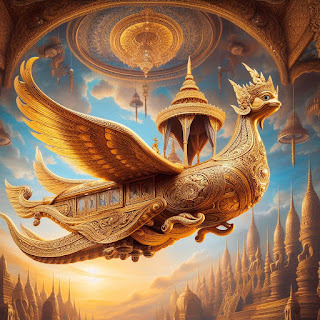 Raka had a son called Khara and a daughter called Surpanakha Malini had a son called Vibhishana
Raka had a son called Khara and a daughter called Surpanakha Malini had a son called Vibhishana While Vibhishana was the most handsome, he was alsodharmic and pious. Ravana was the strongest and bravest. He performed penanceto get a boon from Brahma that he wouldn’t face defeat or death from ‘Gandharvas,Gods, Kinnaras, Anti-Gods, Yaksas, Rakshasas, Serpents, and Bhuta-Spirits’.Brahma granted him the boon, saying none except humans could harm Ravana.
Meanwhile, Kumbhakarna got a boon from Brahma thathe could sleep for as long as he wanted. Vibhishana asked for a different boon.He wanted a boon that would not allow him to deviate from dharma no matterwhat. Pleased, Brahma granted him this and also made him a chiranjeevi, thoughhe was a rakshasa.
The boon (almost assured immortality) made Ravana invincible. He attacked hisbrother Vaisravana-Kubera and captured Lanka. Kubera and the yakshasgandharvas, kinnaras, spirits, etc., left Lanka and moved to Gandhamadana. ThenRavana made Kubera give up the Pushpaka.
Kubera cursed him, “This will never carry you -It will carry him who will kill you in war; because you have insulted me who amelder, you will soon die.”That’s how Ravana became the ruler of Lanka andowned the golden flying vehicle. His two brothers and sister also accompanied himto the kingdom.
 A few years later, Ravana, during one of hispursuits, saw Ramba (an apsara) and sexually assaulted (raped) her when sherefused his advances. Ramba was Nalakubera’s fiancé (technically Ravana’sdaughter-in-law). When Nalakubera found out, he cursed Ravana that his headwould burst into a thousand pieces if he touched any woman without her consent. This incident was mentioned in Aranyaka Parva. Trijata shared the story with Sita to assure her that Ravana would find his end in Rama's hands.
A few years later, Ravana, during one of hispursuits, saw Ramba (an apsara) and sexually assaulted (raped) her when sherefused his advances. Ramba was Nalakubera’s fiancé (technically Ravana’sdaughter-in-law). When Nalakubera found out, he cursed Ravana that his headwould burst into a thousand pieces if he touched any woman without her consent. This incident was mentioned in Aranyaka Parva. Trijata shared the story with Sita to assure her that Ravana would find his end in Rama's hands. Trijata said to Sita: "... Gentle lady, have no fear of Ravana who is cursed by the entire world. You are protected by Nalakubara's curse. This wretched scoundrel earlier raped his own daughter-in-law, Nalakubara’s wife Rambha, and was cursed - he cannot rape any other woman. Your intelligent husband, accompanied by Sumitra's son and protected by Sugriva, will come soon and rescue you." (Section 280)
Ravana waiting for Sita (after kidnapping her) to change her mind and accept him had nothingto do with chivalry but was an act of self-preservation.
Check out a few short stories from Mahabharata.
I’m participating in #BlogchatterA2Z.
The AI images are made on Bing.
April 18, 2024
Q for Queens in Mahabharata - Mahabharata Mashup
Namaste,
For me, there’s no kingdom without a queen. Womenhad played varied roles over the years. Mahabharata has many queens, someknown, some powerful, and some left unnamed.
Here, I’ll mention three queens from threegenerations who set the stage for future events. Of course, queens likeSatyavati (Bhishma’s stepmother), Rukmini (Krishna’s wife), Sudeshna (KingVirata’s wife), Damayanti (King Nala’s wife), etc., also had important roles.Even Kunti (though she was technically not a queen for most of her life)contributed to the events.
River Goddess Ganga As you read in the post about Ashta Vasus, Ganga wasdestined to give birth to the Vasus. For this, she had to marry King Shantanu(son of Pratipa) of the Kuru dynasty.
As you read in the post about Ashta Vasus, Ganga wasdestined to give birth to the Vasus. For this, she had to marry King Shantanu(son of Pratipa) of the Kuru dynasty. Even before the Vasus were cursed, King Mahabhisa ofthe Ikshvaku race was cursed by Brahma for staring at Ganga doing an importantritual. The king was to be born as a human, and Ganga would help break thecurse. Later, the Vasus requested her to give birth to them when they had to beborn as humans.
One day, when King Pratipa was doing tapasya at thebanks of the Ganga, she went to sit on his right leg and asked him to marryher. The king said the right side was meant for daughters and daughter-in-law,so he would welcome her as his son’s wife and made a promise. Years later, hisson Shantanu went to the river bank, saw Ganga standing there, and fell in lovewith her. She agreed to marry him only if he promised never to question heractions. He agreed. However, unable to see her drown their children, Shantanuquestioned her. She revealed the truth and left with the eighth child(Bhishma). Once the child was trained and old enough, she handed him over toShantanu as the heir to the throne.
The kingdom of Hastinapura flourished with abundanceand prosperity when Ganga was the queen and lived in the palace with Shantanu.And why not? She was the source of life, after all!
Queen GandhariGandhari was the princess of Gandhara (present-dayAfghanistan), the daughter of King Subala. Gandhari worshipped Shiva and got aboon that she would give birth to a hundred sons. When Bhishma got to know ofthis, he approached King Subala with a proposal to get Gandhari married toDhritarastra. However, the king didn’t agree, as Dhrtarastra was blind. Bhishmawon him over with persistence. When Gandhari heard of this, she showed her acceptance bywrapping a silk cloth over her eyes. She said she didn’t wish to see his lackof sight and would continue to keep the blindfold until her lastbreath.

Gandhari was shown as a regular flawed human inMahabharata. Be it her jealousy when Kunti delivered a child or her desire toprotect her son Dhuryodhana despite knowing his flaws. In Udyoga Parva,Gandhari was also asked to come to the Sabha to convince Dhuryodhana to makepeace with the Pandavas. Her words were quite ruthless compared toDhritarastra, who loved his sons a little too much (and was already jealous ofthe Pandavas). She straight out told Dhuryodhana that he was wicked and wouldremember their warnings when he faced death in the form of Bhima. She addedthat she could see it was too late to change his mind.
While Gandhari’s role as a queen is not explored,she does come into the limelight with her curse on Krishna. The Curse of Gandhari by Aditi Banerjee presents theepic from her POV. (I haven’t read the book, but know Aditi is a dharmicperson)
Empress DrapuadiDraupadiis the princess of Panchala, the daughter of King Draupada, and the wife ofthe five Pandava brothers. Draupadi was born from the yagna fire and is knownas Yagnaseni. She wasn’t born as a child but as a teenager, along with herbrother Dhrstadyumna, who came out of the yagna fire wearing armor and holdinga sword.
Draupadi was the queen of Indraprastha and became anempress when Yudhistira completed the Rajasuya. However, she had to spend thenext thirteen years of her life in exile when Yudhistira lost the game of diceto Shakuni. After the war, Draupadi became the queen of Hastinapura and ruledthe kingdom for 36 years.

In Aranyaka Parva, Draupadi and Satyabhama had aconversation in the forest. Krishna and Satyabhama went to visit the Pandavasto offer support. Draupadi spoke about her role as a wife, daughter-in-law, andqueen. We learn she was right in the middle of things and had complete controlover the administration and finances.
To quote Draupadi, “It was I who listened tocomplaints and laid down rules to be observed. I knew the entire palace system,from the maidservants and other palace workers to the palace cowherds andshepherds. I was the one, not the Pandavas, who knew the details of income andexpenditure; I alone knew their total revenue. My husbands went about theirvarious pursuits, and I managed their treasury, as inexhaustible as Varuna’socean.”
Draupadi was capable, confident, and assertive.Unlike the modern retellings, she wasn’t presented as an arrogant woman but anassertive one who spoke her mind when the need arose. She wasn’t proud of herbeauty either. Her beauty was only a part of her but didn’t represent her entirepersonality. In a way, some feminist retellings have done more disservice toDraupadi than elevate her.
I’m participating in #BlogchatterA2Z.
The AI images are made on Bing.
April 17, 2024
P for Pasupata Astra: The Battle Between Shiva and Arjuna - Mahabharata Mashup
Namaste,
Have you heard of the battle between Shiva andArjuna? This event happened in Aranyaka Parva when Arjuna was performingtapasya to please Rudra-Shiva and ask him for the Pasupata Astra.
Shiva changed his form into a hunter from the Kiratatribe and went to the mountaintop where Arjuna was his tapasya. Parvati Maa anda group of devotees followed Shiva and were witnesses to the duel.
Both Shiva and Arjuna spotted a boar advancingArjuna and shot it with their arrows. The boar fell dead, revealing itsoriginal form as a demon that came to attack Arjuna.
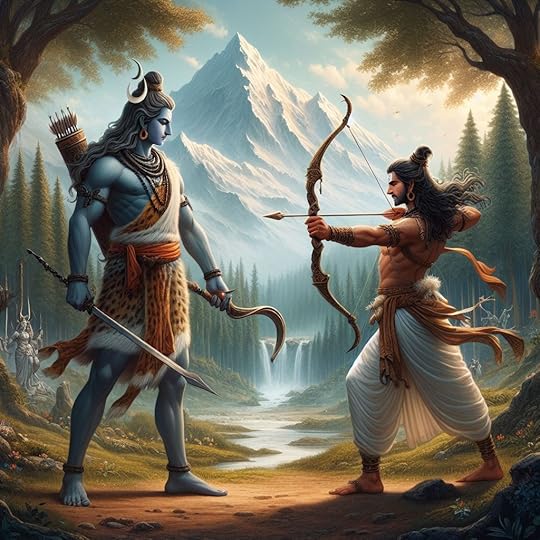
Shiva picked up a fight with Arjuna by asking why heaimed at the boar. Arjuna said Shiva had no right to kill it since the boar wasabout to attack Arjuna (Arjuna killing it would be self-defense). Thingsescalated, and soon, they went from the war of words to direct war.
During the fight (with bows and arrows), Arjuna’ssubconscious prodded, hinting at the truth. More than once, he considered theidea that the hunter-man could be Shiva in disguise. Yet, he continued with thefight. They even got into a fistfight at one point, and Arjuna fell unconsciousfrom the impact. As he regained consciousness, he prayed to Shiva, visualizinghis acts of worship.
When Arjuna opened his eyes, he found the hunterstanding before him, wearing the same garland and flowers Arjuna mentallyoffered to Shiva. He then realized that his intuition was right. He fell atShiva's feet and worshipped him again.
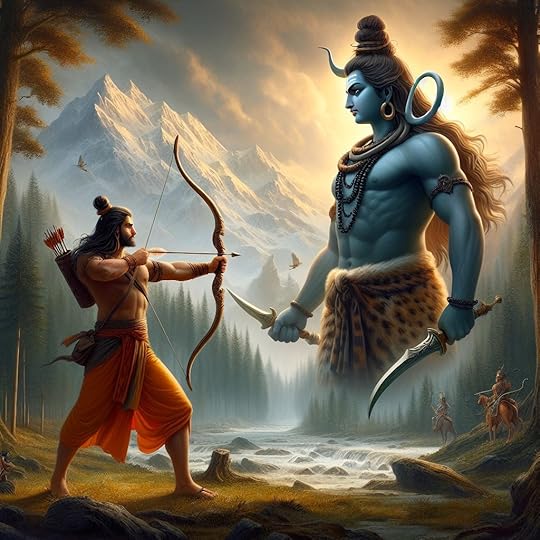 Pleased, Shiva blessed Arjuna and gifted him thepowerful Pasupata astra (also known as Brahmasira) and shared the mantra tosummon it. Shiva advised that the astra should not be used without reason or ata weak enemy.
Pleased, Shiva blessed Arjuna and gifted him thepowerful Pasupata astra (also known as Brahmasira) and shared the mantra tosummon it. Shiva advised that the astra should not be used without reason or ata weak enemy. Interestingly, Arjuna doesn’t use the Pasupata astraduring the war, not for Bhishma or even Karna. It remained unused throughout.However, this episode is vital as it reinforces the role of Gods in the eventsthat occur afterward.
Moreover, Shiva had a prominent role in Mahabharata eventhough Krishna (Vishnu) was the key player. He gave a boon to Amba to take revenge on Bhishma. He gave a boon to Draupadi in her past life. As the god of destruction, Shiva ruled over the battlefield and was sighted by Arjuna (in Drona Parva). He was invoked by Ashwatthaman in Sauptika Parva. Ashwattaman then went on a killing spree by butchering the sleeping warriors in the Pandava camp. The Parva ends with praising the glory of Rudra (the Rudra avatar of Shiva).
Check out this thread by Sutradhar to know more!
I’m participating in #BlogchatterA2Z.
The AI images are made on Bing.
April 16, 2024
O for Omens in Mahabharata - Mahabharata Mashup
Namaskar,
Omens are a recurring theme in our epics andstories. In fact, we love using omens as a foreshadowing tool in storytelling.Mahabharata is no different. There are ample signs indicating the approachingdoom or victory, depending on the situation.
Let’s look at some important omens we come across inMahabharata.
In Adi Parva, Dhuryodhana was born from the firstjar (Gandhari got impatient when Kunti delivered children first. She toreopen her stomach and found a block of flesh instead of a child. Vyasa helpedher cut it into a hundred pieces and stored them in jars filled with ghee). Oneby one, the flesh in the jars became children). Soon after birth, he brayedlike a donkey, and the donkeys in the kingdom answered the call. Strong windsflew throughout, and fires erupted without a cause.
 Vidura told Dhritarastra that these were signs of destruction and that Dhuryodhana would be the cause for bringing ruin to theKuru dynasty. In fact, Vidura even advised Dhritarastra to disown him and notconsider Dhuryodhana his heir. But Dhritarastra doesn’t agree.
Vidura told Dhritarastra that these were signs of destruction and that Dhuryodhana would be the cause for bringing ruin to theKuru dynasty. In fact, Vidura even advised Dhritarastra to disown him and notconsider Dhuryodhana his heir. But Dhritarastra doesn’t agree. In Sabha Parva, after Yudhistira lost the dice game,Duhshasana dragged Draupadi into the court by her hair. She was in her periodand wearing a single cloth wrapped around her body. She still displayed her dignityeven if the Kauravas acted like barbarians. Vidura repeatedly urgedDhritarastra to stop them, but the king didn’t listen to his advice.
However, the insults by Karna, Dhuryodhana, andDuhshasana went too far. Fierce winds blew through the palace. Donkeys, jackals,and vultures cried loudly. The voices echoed inside the courtroom, makingeveryone shiver. Vidura reminded him it was a repeat of events fromDhuryodhana’s birth. This brought some sense to Dhritarastra, who was worriedfor his son’s life and began damage control by offering boons toDraupadi.
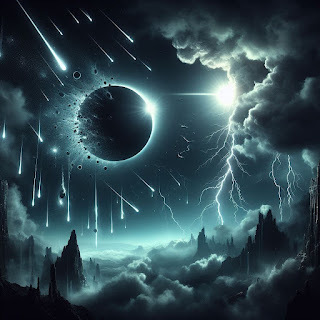 In Udyoga Parva, we have several pages dedicated toomens. The first set is when Krishna went to Hastinapura with a peace treaty.The omens were good and bad – good wherever Krishna passed and bad elsewhere,indicating the result of his attempts.
In Udyoga Parva, we have several pages dedicated toomens. The first set is when Krishna went to Hastinapura with a peace treaty.The omens were good and bad – good wherever Krishna passed and bad elsewhere,indicating the result of his attempts. Later, Bhishma and Drona mentioned omens likethunderbolts striking from cloudless skies, unexpected fires, strange births,etc., urging Dhuryodhana to consider peace.
Karna listed many ill omens to Krishna, saying hehad been having nightmares about the war and knew it was inevitable.
In Bhishma Parva, Vyasa listed countless omens toDhritarastra and warned him that the war would destroy everything he held dear.Vyasa also gives planetary positions (we’ll see this in another post), statingthat everything hints at the Kauravas losing the war to the Pandavas.
In Shalya Parva, a few ill omens were noticed before the clash on the eighteenth day of the battle. Again, right before the famous mace duel between Dhuryodhana and Bhima, Sanjaya listed omens indicating the death of Dhuryodhana. Mysterious darkening of the sky, fierce thunderbolts, meteor showers, echoing cries of jackals with flames in their mouths, and a sudden and unexpected solar eclipse.
Of course, there were a few good omens, too.
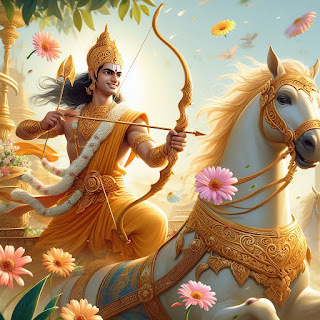 In Drona Parva, Arjuna heard celestial music andfelt a scented breeze caressing his face on the day he was to kill KingJayadratha. Arjuna told Satyaki that these omens meant he would besuccessful.
In Drona Parva, Arjuna heard celestial music andfelt a scented breeze caressing his face on the day he was to kill KingJayadratha. Arjuna told Satyaki that these omens meant he would besuccessful. In Karna Parva, Arjuna again sensed a fresh breezewafting on the battlefield littered with mutilated bodies and celestial musicplaying around him. It indicated that he would kill Karna that day. Karna alsosaw omens but ill ones, predicting his end.
The Kurukshetra War saw two untimely eclipses veryclose to one another. A rare event indeed!
***
I realized I could not conclude the challenge without sharing at least a single video of NTR as Krishna. Not that this is a relevant post, but it'll have to do! This is from the movie Sri Krishna Tulabharam (1966), the scene where Satyabhama donates Krishna to Narada Muni and plans to win him back by offering wealth equivalent to his weight. However, nothing equals Krishna's weight, and he is forced to follow Narada Muni.
I’m participating in #BlogchatterA2Z.
The AI images are made on Bing.



